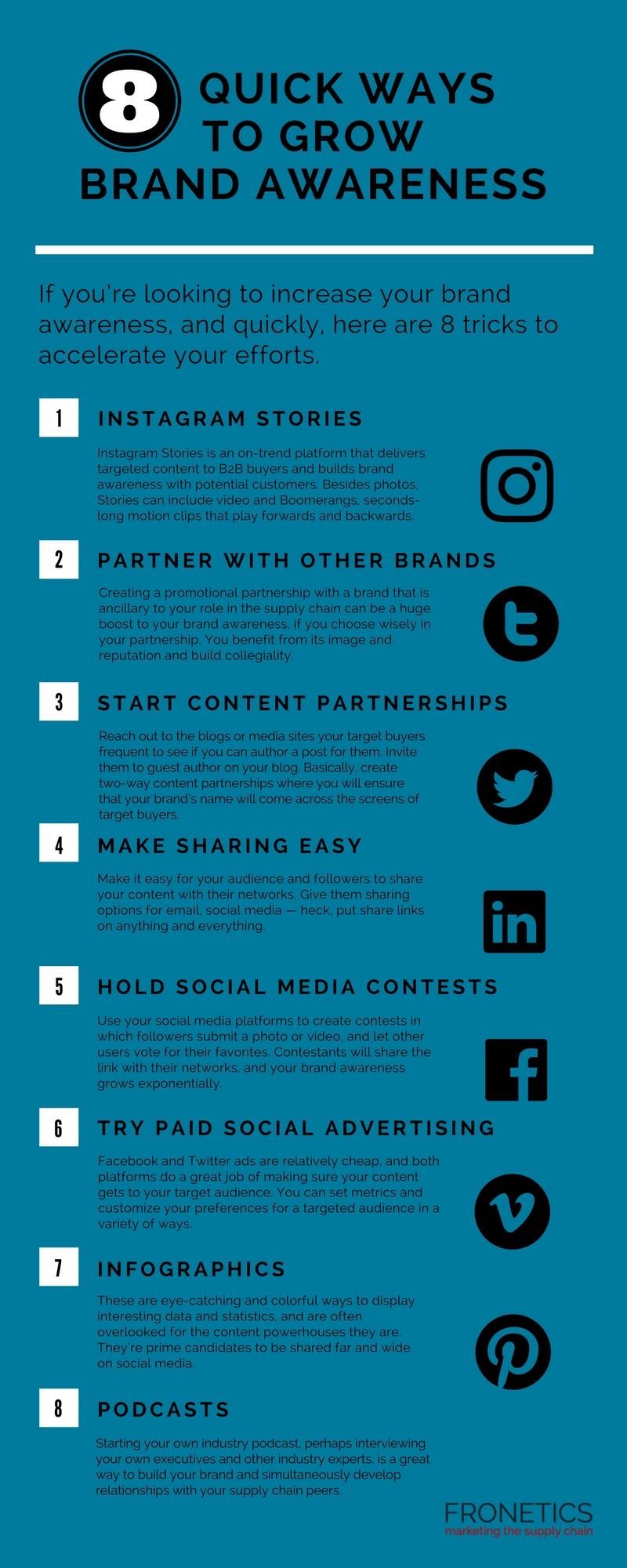
by Fronetics | Oct 10, 2018 | Blog, Content Marketing, Logistics, Marketing, Social Media, Supply Chain
Follow these 3 steps to use social media to promote events, conferences, and other business occasions.
Social media is a powerhouse tool for growing brand awareness, audience engagement, and lead generation. It’s also one of the most effective ways out there to promote special events.
[bctt tweet=”Social media is a powerhouse tool for growing brand awareness, audience engagement, and lead generation. It’s also one of the most effective ways out there to promote special events.” username=”Fronetics”]
But simply creating a Facebook event and sharing it once or twice won’t get you the most bang for your buck. You need to be strategic about your use of social media to promote events and conferences.
Follow these 3 steps to make the most of social media as a promotional tool.
3 steps to use social media to promote events for your business
1. Choose your platform wisely
Not all social media channels are created equal, and neither are all events. Finding the platform that suits the unique needs of your event or conference is a big part of a successful promotional campaign. For instance, Facebook is a great option for large-scale public events, since it lets you hone in on your target audience in specific ways.
On the other hand, for corporate events like seminars, conferences, and continuing education programming, LinkedIn is your best bet. LinkedIn lets you set up your event and allows attendees to network with each other before the event even happens.
When it comes to more informal events, Instagram is a great way to identify and engage with potential attendees. The platform’s highly visual nature is ideal for sharing imagery related to your event, and it’s an ideal place to use hashtags.
2. Pick a hashtag
If your social media circle includes people under the age of 35, you’ve probably noticed that pretty much every wedding, graduation party, and even family vacation has its own hashtag these days. Corporate events are no different. Hashtags are a fun and memorable way to foster a sense of community, and they have the important benefit of being an easy way to group all information, questions, and comments about your event.
The most effective hashtags tend to be short, memorable, and easy to read. It’s also worthwhile to do a quick search to make sure your hashtag hasn’t been used before. In all posts related to your event, use your hashtag prominently, and encourage your audience to do the same if they share or post independently.
3. Don’t forget about content
One of the most effective ways to promote events on social media is — you guessed it — content. Blog posts, related case studies, testimonials from former events, promotional interviews with potential attendees or keynote speakers, videos, case studies, and white papers/industry reports are all content types to consider.
You don’t have to reinvent the wheel every time you promote a new event. Chances are, existing content can be repurposed and reposted on social media channels. You’re serving the dual purpose of promoting your event and driving more traffic to view and interact with your content.
When it comes to promoting events, social media is your friend. Approaching it strategically can help you raise awareness, attendance, and interaction and reach for your brand.
How do you use social media to promote events?
Related posts:


by Fronetics | Oct 8, 2018 | Blog, Content Marketing, Logistics, Marketing, Social Media, Strategy, Supply Chain
Social media’s ability to exponentially grow brand awareness and introduce your content to unseen audiences can’t always be measured in dollars.
One of the hardest parts about implementing a social media strategy is struggling to measure its success. While most B2B marketing professionals agree that a social media presence is crucial to any content marketing strategy, it can be hard to justify the investment when you can’t quantify the results.
“Social media is not just a spoke on the wheel of marketing. It’s becoming the way entire bicycles are built,” says Ryan Lilly, author.
This doesn’t mean that your business shouldn’t be diving — head first — into social media. With over 3.1 billion people using social media, businesses have to recognize the importance of social media as a part of a robust marketing strategy.
[bctt tweet=” With over 3.1 billion people using social media, businesses have to recognize the importance of social media as a part of a robust marketing strategy.” username=”Fronetics”]
Marketers need to start thinking about social media success in terms of potential, instead of immediate dollars.
Social media: the reach
One of the most valuable aspects of social media is the ability to engage with new audiences, all the time. That means you not only have access to a new customer base, but to their connections as well.
When your followers engage with your brand on social media, they also engage with their own personal network. This organic reach is one of the most beneficial aspects of social media — and it’s not easy to put a dollar amount on. The potential to nurture leads and ultimately impact sales are huge, but it won’t happen overnight.
Here’s Kettie Laky, Social Media Director at Fronetics, to share why you need to frame social media success in terms of potential, and not just dollars.
Video: Measure social media success in terms of potential, not just dollars.
It’s time we start thinking about social media success in this new way: in terms of potential and expanding value, rather than just immediate dollar amounts. How have you worked to measure the success of your social media strategy?
Related posts:


by Fronetics | Jun 6, 2018 | Blog, Content Marketing, Leadership, Logistics, Marketing, Supply Chain, Talent
Organizations that promote corporate social responsibility (CSR) are reaping the benefits of their good deeds, including increased brand awareness and employee satisfaction.
Corporate social responsibility is a hot topic these days. Generally speaking, it’s a pretty broad term to describe how a company is working to improve its community. Companies can demonstrate CSR in lots of different ways, including donations, employee volunteering, implementing environmentally safe processes, and more.
These efforts, whether large or small, say a lot about your organization. Companies that consistently demonstrate their commitment to CSR initiatives are recognizing their ability to help their community and acting on that knowledge.
[bctt tweet=”55% of consumers are willing to pay more for products from socially responsible companies.” username=”Fronetics”]
And the public is taking notice. 55% of consumers are willing to pay more for products from socially responsible companies. What does that mean for you? It means that corporate social responsibility is as good for your community as it is for your own brand.
Here are four major benefits of corporate social responsibility.
4 benefits of corporate social responsibility.
1. Increased employee satisfaction
The way a company treats its community says a lot about how a company treats its employees. People that feel respected and supported in their jobs are often more productive and satisfied at work. Giving your employees opportunities to volunteer, especially during working hours, creates a sense of community within your organization, as well as a connection to the surrounding community. Employees will gain motivation and pride in their work through these personal-development opportunities.
Employees that are actively involved in the community are also acting as brand ambassadors. The more engaged and invested they are in your organization, and the greater community, the more productive they will be. In fact, companies with highly engaged employees saw 21% better business profitability. What could be better than happy employees promoting your brand while helping their neighbors?
2. Improved public image
In today’s digital era, companies that demonstrate corporate social responsibility are gaining exposure — and praise — for their involvements. Your brand’s reputation can only benefit from good deeds in your community. Think about it: Consumers feel good when they buy products and services from companies that are helping their community.
Don’t miss the opportunity to publicize your CSR initiatives and spread the word about your community involvement. Tweet, post, and share your social programs. Letting the public know about your good deeds will only work to increase your brand’s public image.
3. Increased customer loyalty
In a 2016 Neilson survey, 56% of participants said “a brand being known for its social value” was a top purchasing driver. And 53% of participants said “a brand with community commitment” was a leading purchasing driver.
Customers are more likely to be loyal to your brand if your corporate values align with their personal ones. What’s more, millennials — the largest population, over baby boomers, by 2019 — are driving the market these days. According to Forbes contributor Sarah Landrum, millennials prefer to do business with “corporations and brands with pro-social messages, sustainable manufacturing methods, and ethical business standards.” CSR programs work to showcase your corporate values and demonstrate that team work, community involvement, and engagement are at the top of your core values.
4. Increased creativity
Want your employees to start thinking outside of the box? Want to increase innovation in your company? CSR initiatives encourage your employees to try new things and get re-energized about their jobs.
Through this social involvement, employees will feel empowered to start contributing to the bigger picture. They might come up with new ideas about products or internal processes or innovate new problem-solving solutions. When you demonstrate your company’s values and passions through community giving, employees will feel encouraged (and supported) to develop new and better ways to do their jobs.
CSR is a win/win.
A commitment to corporate social responsibility is no longer optional. Companies need to understand that CSR affects their internal (employee engagement, productivity, turnover rate) and external (increased sales, customer loyalty, brand awareness) growth. By creating and participating in CSR initiatives, companies have the opportunity showcase their core values and create trust among your employees and your buyers.
What corporate social responsibility initiatives have you implemented?
Related posts:

SaveSave

by Fronetics | May 3, 2018 | Blog, Content Marketing, Logistics, Marketing, Social Media, Strategy, Supply Chain
If you’re looking to grow brand awareness fast, here are 8 tricks to boost your efforts.
Have you ever noticed how some brands seem to have crept into popularity overnight? You’ve never heard of them, and then, all of sudden, they’re everywhere.
Their brand awareness has sky rocketed, and they’re achieving every company’s ultimate goal: Customers know about them. So what’s their secret?
Here at Fronetics, we don’t believe they have a secret. We believe that they took advantage of content marketing and its many benefits — growing brand awareness included. They were able to scale their growth in a short amount of time, a true success story for the digital era. Companies like Uber and Yelp have used these tips to implement small changes that yielded large results.
Remember, in order to grow brand awareness, you need to be proactive. It’s time to steer away from some of the traditional marketing methods, which don’t take into account how modern B2B buyers research vendors. Start putting your content marketing strategy to the test.
[bctt tweet=”To grow brand awareness fast, it’s time to steer away from some of the traditional marketing methods, which don’t take into account how modern B2B buyers research vendors. ” username=”Fronetics”]
If you’re looking to increase your brand awareness fast, there’s no better place to start than with content marketing. Check out these 8 tips for using content marketing to grow your brand awareness fast.
Infographic: 8 ways to grow brand awareness fast

(Made with Canva)
How do you grow brand awareness fast?
Related posts:


by Fronetics | Apr 25, 2018 | Blog, Content Marketing, Logistics, Marketing, Social Media, Supply Chain
Supply chain leaders should use these 5 social media tips to grow brand awareness and increase your company’s profile as an employer.
Like most busy executives, it’s hard to find time for your daily tasks and projects without adding social media into the mix. But having a presence on social media is no longer optional for leaders. It’s a necessity.
Though branding might not come easily for some supply chain management executives, it is key in today’s digital world for positioning yourself as a thought leader in your industry, as well as gaining positive traction as an employer.
We’ve talked a lot about the supply chain talent gap. Here’s where a consistent, informative social media presence could help you and your company.
Millennials in the workforce are more likely to apply for jobs with companies that have a strong social media presence. They want to work for leaders that are openly posting about industry trends, collaborating with competitors, and working toward innovative products and services. What better way to highlight your role as an industry leader than through social media?
Getting started can be intimidating. There are lots of different social media channels. And even more options regarding content within those channels. Do you start a blog? Post on Twitter? Upload videos to YouTube? It’s not as easy as just writing a few blog posts and throwing them up on Facebook.
So how do you get started cultivating a social media presence? Here are 5 tips to help any supply chain leader.
Infographic: 5 social media tips for supply chain leaders

(Made with Canva)
Don’t let the hype of social media deter you. A strong personal brand is a major asset to any executive or aspiring executive. It doesn’t have to be a chore. It can become a fun and fulfilling part of your work routine, and it pays off. We hope these tips are useful even if you’ve been active on social media in a professional capacity before!
Related posts:












